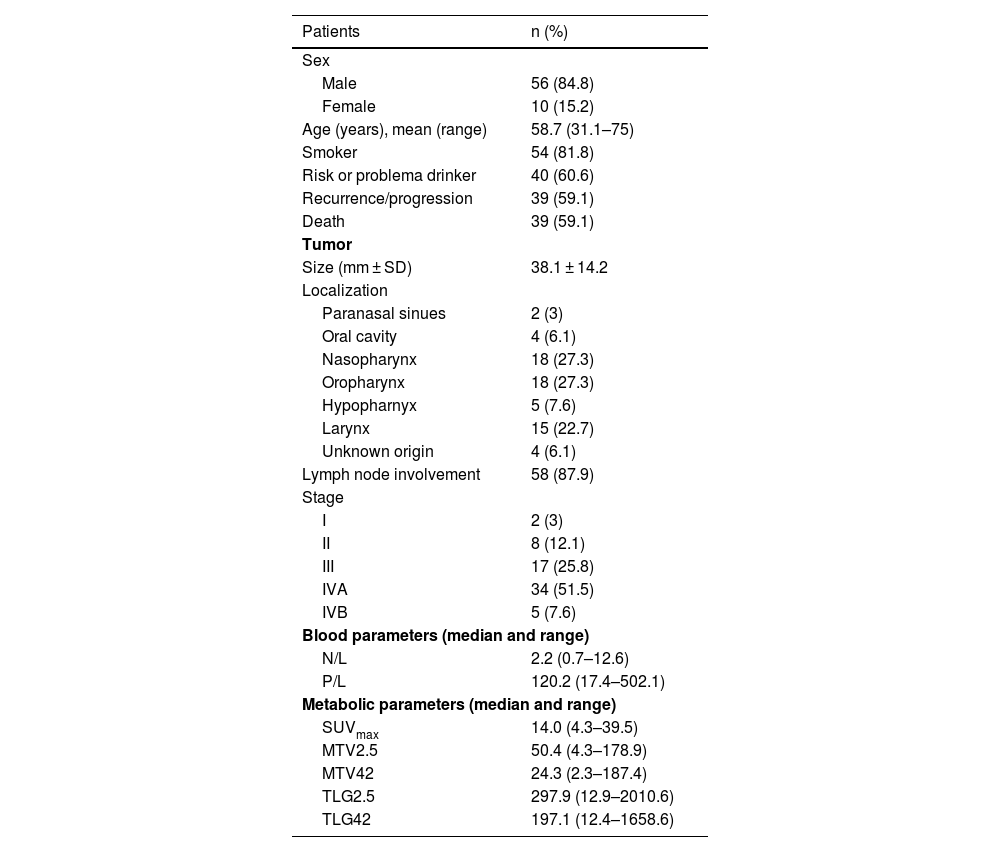To determine the usefulness of neutrophil/lymphocyte (N/L) and platelet/lymphocyte (P/L) ratios as well as quantitative [18F]FDG PET/CT parameters as prognostic factors for overall survival (OS), cancer-specific survival (CSS) and progression-free survival (PFS) in patients with head and neck squamous cell carcinoma (HyN).
Material and methodsSixty-six patients (56 men) diagnosed with HyN carcinoma were retrospectively assessed over an 8-year interval. Maximum SUV (SUVmax), metabolic tumour volume (MTV) and total lesion glycolysis (TLG) parameters were determined from the PET/CT study at diagnosis. After treatment with chemoradiotherapy, patient survival was assessed. The Cox regression model and the Kaplan–Meier method were used to analyse prognostic factors and survival curves.
ResultsMedian follow-up was 50.4 months, with 39 recurrences-progressions and 39 deaths. In the univariate analysis, metabolic parameters, except SUVmax, were predictive factors for all three survivals and the two blood parameters were predictive for OS and EFS. TLG was the only predictive factor in the multivariate analysis. The three survival curves were significantly different for the metabolic parameters and the OS curve for the N/L ratio. Correlations were seen between N/L ratio, MTV and TLG. No correlations were demonstrated between P/L ratio and metabolic parameters.
ConclusionThe use of haematological and metabolic markers would allow to identify patients with a high risk of recurrences and por survival and to individualise treatment by applying more aggressive therapies.
Determinar la utilidad de los cocientes neutrófilos/linfocitos (N/L) y plaquetas/linfocitos (P/L) así como de parámetros cuantitativos de la PET/TC con [18F]FDG como factores pronósticos para la supervivencia global (SG), supervivencia cáncer específica (SCE) y supervivencia libre de progresión (SLP) en pacientes con carcinoma escamoso de cabeza y cuello (CyC).
Material y métodosSe valoraron retrospectivamente 66 pacientes (56 hombres) diagnosticados de CyC durante un intervalo de 8 años. Se determinaron los parámetros SUV máximo (SUVmax), volumen metabólico tumoral (MTV) y glucólisis tumoral total (TLG) del estudio PET/TC al diagnóstico. Tras tratamiento con quimiorradioterapia, se valoró la supervivencia de los pacientes. El modelo de regresión de Cox y el método de Kaplan-Meier se utilizaron para analizar factores pronósticos y curvas de supervivencia.
ResultadosEl seguimiento medio fue de 50,4 meses, produciéndose 39 recurrencias- progresiones y 39 fallecimientos. En el análisis univariante los parámetros metabólicos, excepto el SUVmax, fueron factores predictivos para las tres supervivencias y los dos parámetros sanguíneos lo fueron para la SG y la SCE. La TLG fue el único factor predictivo en el análisis multivariante. Las tres curvas de supervivencias fueron significativamente diferentes para los parámetros metabólicos y la curva de SG para el cociente N/L. Se apreciaron correlaciones entre el cociente N/L, el MTV y la TLG. No se demostraron correlaciones entre el cociente P/L y los parámetros metabólicos.
ConclusiónEl uso de marcadores hematológicos y metabólicos permitiría identificar pacientes con un alto riesgo de recurrencias y pobre supervivencia e individualizar el tratamiento aplicando terapias más agresivas.
Artículo

Revista Española de Medicina Nuclear e Imagen Molecular (English Edition)
Comprando el artículo el PDF del mismo podrá ser descargado
Precio 19,34 €
Comprar ahora













